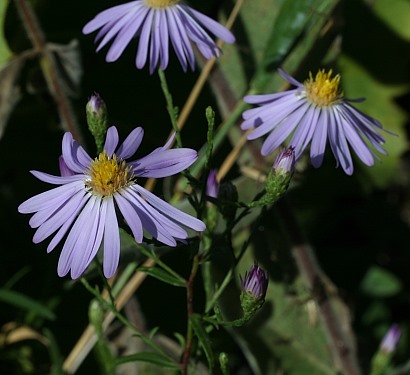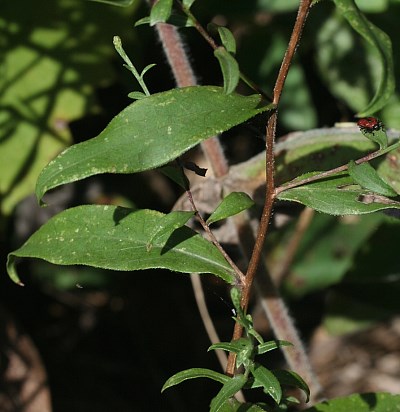Description: This perennial wildflower is 1½–3' tall and more or less erect, forming occasional side branches. The stems usually have lines of hair, although sometimes they are glabrous; young stems are light to medium green, while older stems become brown. The alternate leaves along these stems are up to 4" long and ¾" across; they are narrowly ovate, lanceolate, or oblanceolate, smooth along the margins, and sessile. The upper surface of each leaf is dark green and hairless. The central stem terminates in a panicle of flowerheads that is usually longer than wide; some of the side stems also produce flowerheads in smaller panicles. The branches of each panicle are stiffly ascending; they are covered with small scale-like bracts. Each flowerhead is about ¾–1½" across, consisting of 15-25 ray florets and a similar number of disk florets. The ray florets are lavender to blue-violet, while the disk florets are yellow to reddish purple. Both kinds of florets are fertile. The base of each mature flowerhead (the involucre) is often shaped like a top or turban (turbinate) and it is about 7-11 mm. in length. The exterior of the involucre is covered with appressed scales (phyllaries) in several series; the apex of each scale is obtuse, rather than pointed. The blooming period occurs during early to mid-fall and lasts about 3 weeks. Each floret is replaced by an achene with a tuft of tawny hairs. This small achene is oblongoid with several ribs and often finely pubescent. On mature plants, the root system consists of a woody caudex with fibrous roots underneath. Occasionally, rhizomes are produced that can form vegetative offsets.

Cultivation:
The
preference is partial sun, mesic to slightly dry conditions, and a
loamy or rocky soil with a somewhat acidic pH. The lower leaves often
become withered or discolored before the blooming period occurs during
the fall. If this wildflower is spoiled in the garden with fertilizer
and too much water, it may become top-heavy and require staking later
in the year.
Range & Habitat:
The native Turbinate Aster is occasional in the southern half of
Illinois and
absent in the northern half of the state (see Distribution
Map). Illinois lies in the NE corner of its range in the
United States. Habitats include prairies, savannas, openings in upland
woodlands, borders of upland woodlands, thinly wooded slopes and
bluffs, cliffs, rocky glades, and roadsides. This species is often
found where sandstone, chert, or granite is close to the surface of the
ground.
Faunal Associations:
The nectar and pollen of the flowers attract various bees, bee flies,
butterflies, skippers, and other insects. Bee visitors include
honeybees, bumblebees, leaf-cutting bees (Megachile spp.),
digger bees (Melissodes spp.), and Halictid bees.
The caterpillars of the butterflies Chlosyne nycteis
(Silvery Checkerspot) and Phyciodes tharos (Pearl
Crescent) feed on the foliage of asters (Symphyotrichum spp.);
the caterpillars of many species of moths also feed on
various parts of asters. Leaf Beetles that often feed on asters include
Exema canadensis, Microrhopala xerene,
Ophraella pilosa, and Sumitrosis
inaequalis. The value of asters to vertebrate animals is
somewhat limited. The Wild Turkey sometimes eats the seeds and foliage;
White-Tailed Deer and the Cottontail Rabbit also eat the foliage.

Photographic
Location:
The wildflower garden of the webmaster in Urbana, Illinois.
Comments:
This aster is one of the last wildflowers to bloom during the fall. It
has attractive flowerheads that are larger than average in size;
underneath these flowerheads, the stiffly ascending branches appear
nearly naked because their scale-like bracts are so small. The
Turbinate Aster (Symphyotrichum
turbinellum) can be distinguished from other asters (Symphyotrichum
spp.) as follows: 1) its flowerheads are at least ¾" across,
2) the
branches of each panicle are covered with small scale-like bracts, 3)
the leaves along the stems are sessile and never cordate at the base,
4) the margins of the leaves are entire or slightly crenate, 5) the
tips of the phyllaries are obtuse, rather than pointed, and 6) the
stems often have lines of hairs. Sometimes, this wildflower is called
the Prairie Aster, but it is more common in savannas or thin upland
woodlands (at least in Illinois).